University EBP Report: Factors Predicting Hodgkin's Lymphoma Relapse
VerifiedAdded on 2022/09/13
|20
|5837
|14
Report
AI Summary
This report employs an evidence-based practice approach to investigate the factors associated with the relapse of Hodgkin's lymphoma (HL). It begins with a detailed search strategy utilizing databases like Medline, PsycINFO, CINAHL, and BNI, employing specific keywords, Boolean operators, and inclusion/exclusion criteria to identify relevant peer-reviewed articles published within the last ten years. The report focuses on articles emphasizing relapse factors in adult patients, excluding case studies and non-English publications. The methodological quality of the selected articles is assessed. A specific paper by Shah et al. (2016) is critically appraised using the CASP tool, examining risk factors predicting outcomes for primary refractory HL patients treated with salvage chemotherapy and autologous stem cell transplantation. The report aims to provide insights into predicting factors, which include anaemia, age, presence of B symptoms, low-performance status (PS), extranodal relapse, bulky disease or relapse in the previous radiation field, and their impact on patient outcomes, contributing to improved patient care strategies.
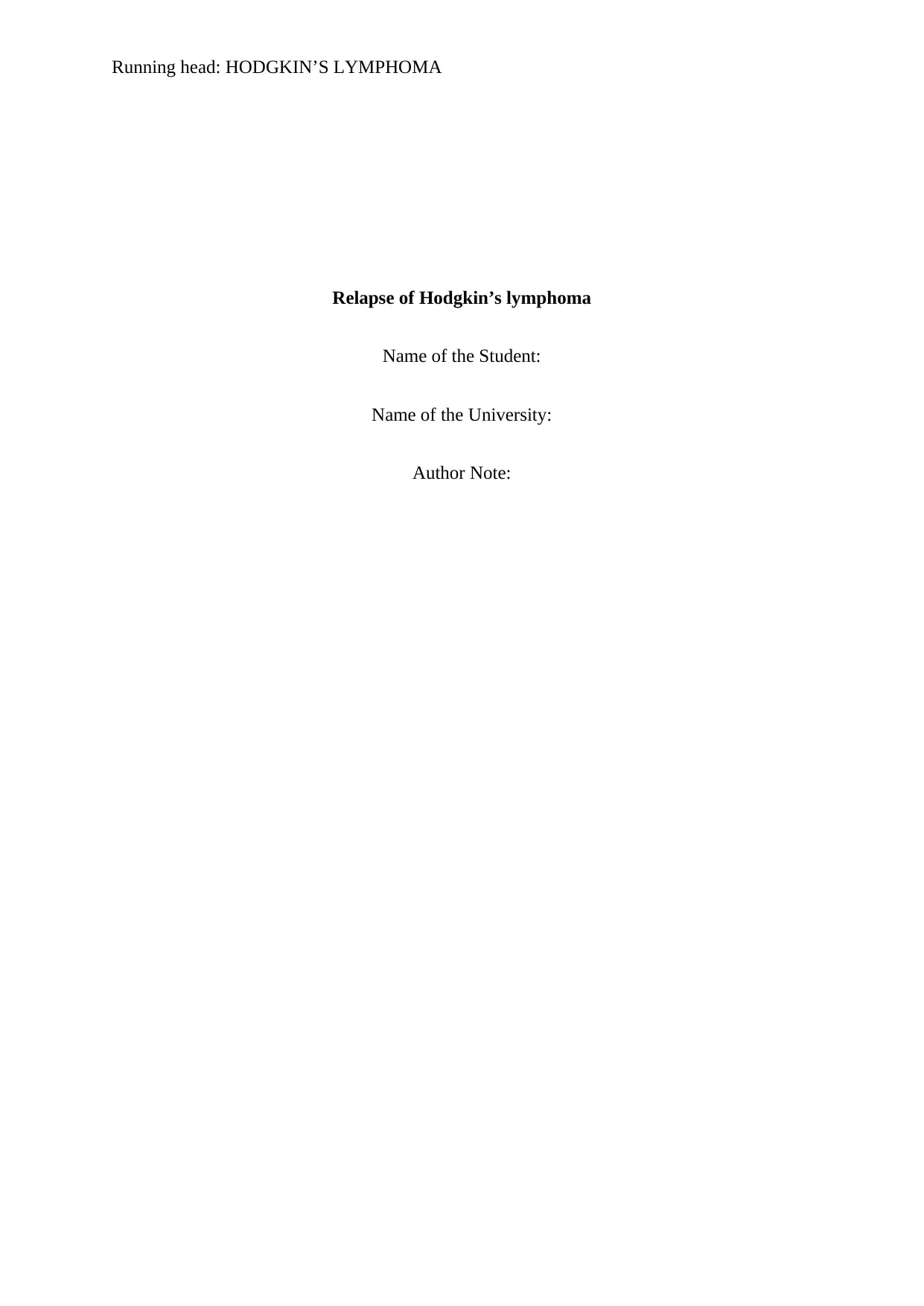
Running head: HODGKIN’S LYMPHOMA
Relapse of Hodgkin’s lymphoma
Name of the Student:
Name of the University:
Author Note:
Relapse of Hodgkin’s lymphoma
Name of the Student:
Name of the University:
Author Note:
Paraphrase This Document
Need a fresh take? Get an instant paraphrase of this document with our AI Paraphraser
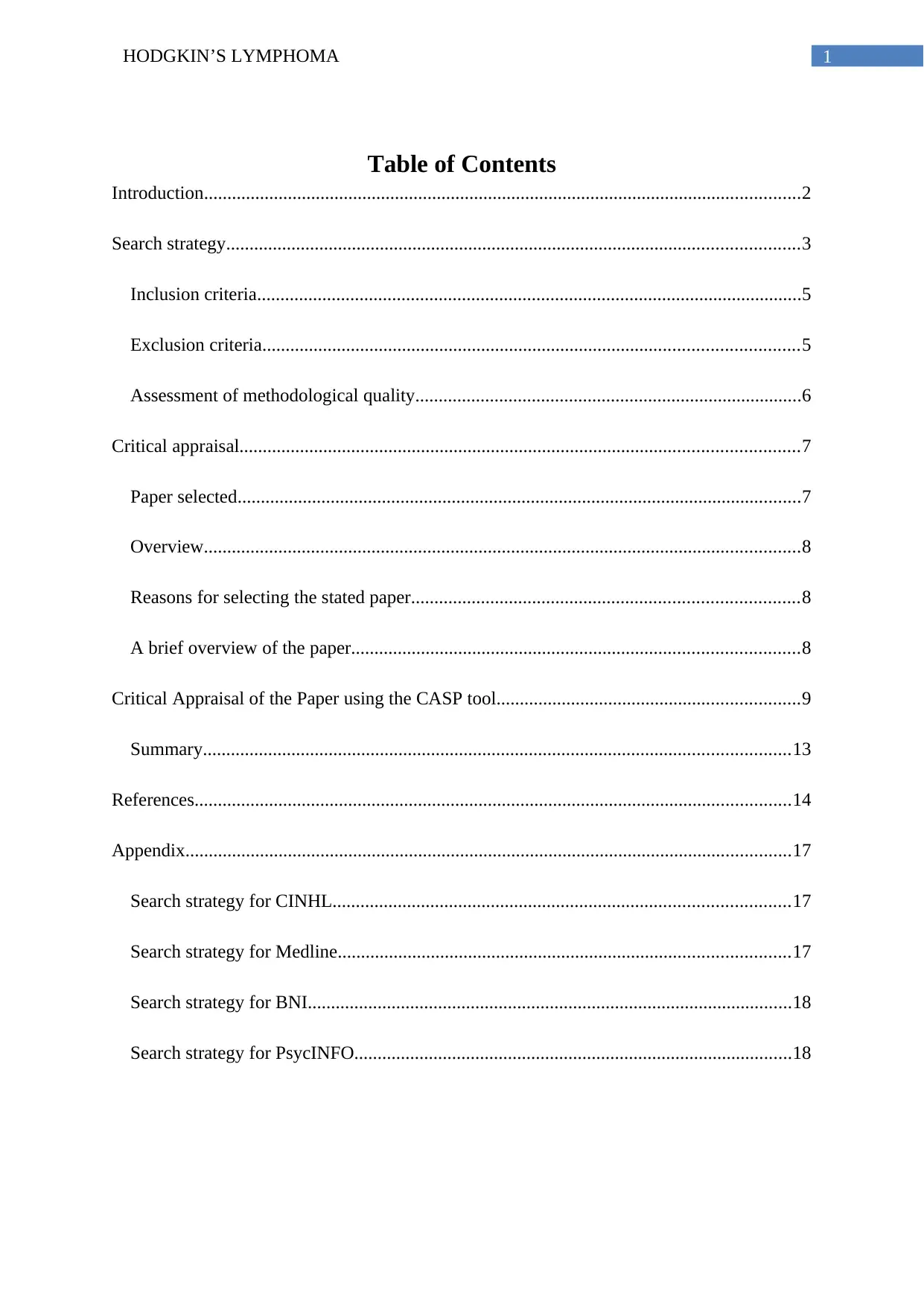
1HODGKIN’S LYMPHOMA
Table of Contents
Introduction................................................................................................................................2
Search strategy...........................................................................................................................3
Inclusion criteria.....................................................................................................................5
Exclusion criteria...................................................................................................................5
Assessment of methodological quality...................................................................................6
Critical appraisal........................................................................................................................7
Paper selected.........................................................................................................................7
Overview................................................................................................................................8
Reasons for selecting the stated paper...................................................................................8
A brief overview of the paper................................................................................................8
Critical Appraisal of the Paper using the CASP tool.................................................................9
Summary..............................................................................................................................13
References................................................................................................................................14
Appendix..................................................................................................................................17
Search strategy for CINHL..................................................................................................17
Search strategy for Medline.................................................................................................17
Search strategy for BNI........................................................................................................18
Search strategy for PsycINFO..............................................................................................18
Table of Contents
Introduction................................................................................................................................2
Search strategy...........................................................................................................................3
Inclusion criteria.....................................................................................................................5
Exclusion criteria...................................................................................................................5
Assessment of methodological quality...................................................................................6
Critical appraisal........................................................................................................................7
Paper selected.........................................................................................................................7
Overview................................................................................................................................8
Reasons for selecting the stated paper...................................................................................8
A brief overview of the paper................................................................................................8
Critical Appraisal of the Paper using the CASP tool.................................................................9
Summary..............................................................................................................................13
References................................................................................................................................14
Appendix..................................................................................................................................17
Search strategy for CINHL..................................................................................................17
Search strategy for Medline.................................................................................................17
Search strategy for BNI........................................................................................................18
Search strategy for PsycINFO..............................................................................................18

2HODGKIN’S LYMPHOMA
⊘ This is a preview!⊘
Do you want full access?
Subscribe today to unlock all pages.

Trusted by 1+ million students worldwide
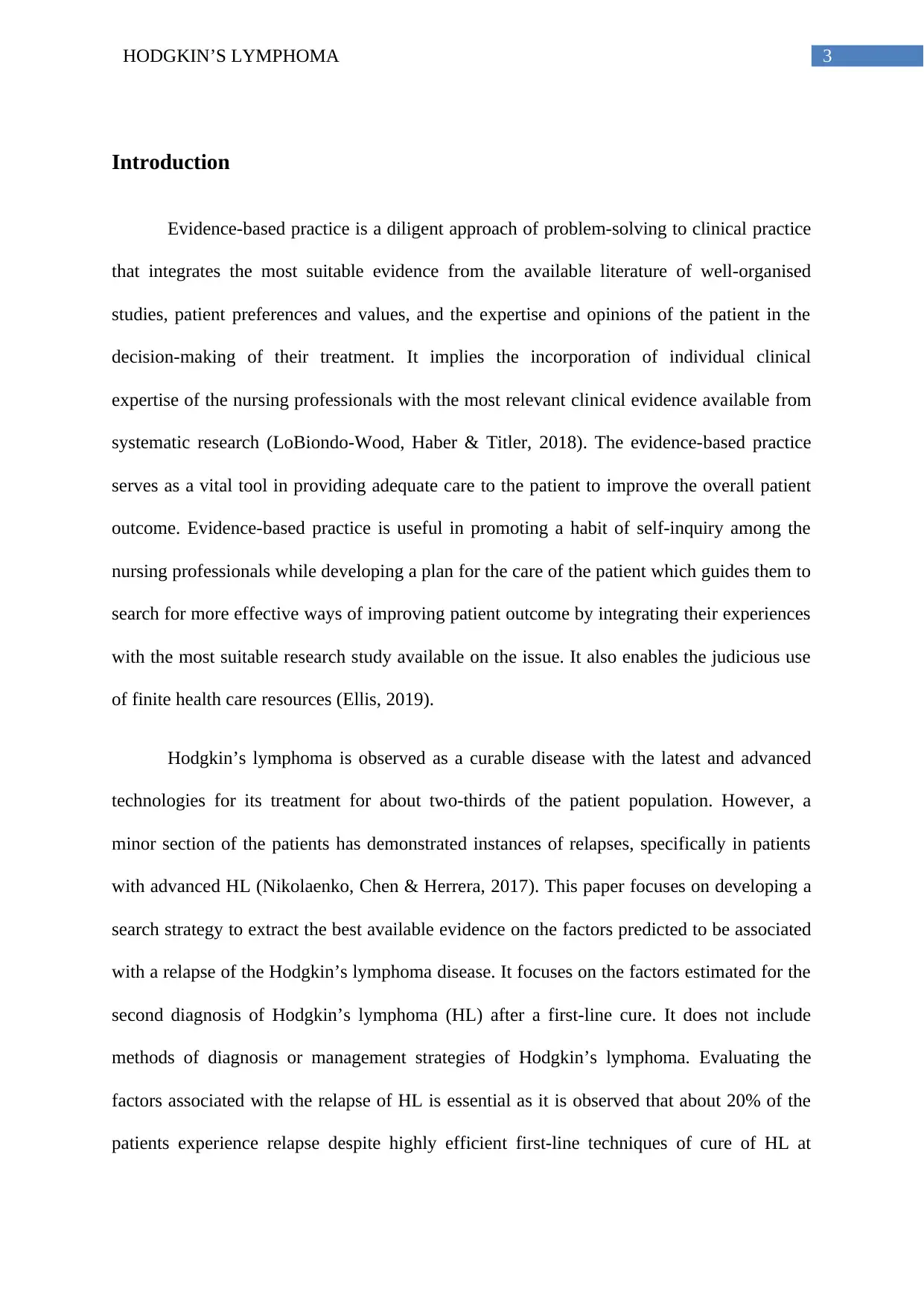
3HODGKIN’S LYMPHOMA
Introduction
Evidence-based practice is a diligent approach of problem-solving to clinical practice
that integrates the most suitable evidence from the available literature of well-organised
studies, patient preferences and values, and the expertise and opinions of the patient in the
decision-making of their treatment. It implies the incorporation of individual clinical
expertise of the nursing professionals with the most relevant clinical evidence available from
systematic research (LoBiondo-Wood, Haber & Titler, 2018). The evidence-based practice
serves as a vital tool in providing adequate care to the patient to improve the overall patient
outcome. Evidence-based practice is useful in promoting a habit of self-inquiry among the
nursing professionals while developing a plan for the care of the patient which guides them to
search for more effective ways of improving patient outcome by integrating their experiences
with the most suitable research study available on the issue. It also enables the judicious use
of finite health care resources (Ellis, 2019).
Hodgkin’s lymphoma is observed as a curable disease with the latest and advanced
technologies for its treatment for about two-thirds of the patient population. However, a
minor section of the patients has demonstrated instances of relapses, specifically in patients
with advanced HL (Nikolaenko, Chen & Herrera, 2017). This paper focuses on developing a
search strategy to extract the best available evidence on the factors predicted to be associated
with a relapse of the Hodgkin’s lymphoma disease. It focuses on the factors estimated for the
second diagnosis of Hodgkin’s lymphoma (HL) after a first-line cure. It does not include
methods of diagnosis or management strategies of Hodgkin’s lymphoma. Evaluating the
factors associated with the relapse of HL is essential as it is observed that about 20% of the
patients experience relapse despite highly efficient first-line techniques of cure of HL at
Introduction
Evidence-based practice is a diligent approach of problem-solving to clinical practice
that integrates the most suitable evidence from the available literature of well-organised
studies, patient preferences and values, and the expertise and opinions of the patient in the
decision-making of their treatment. It implies the incorporation of individual clinical
expertise of the nursing professionals with the most relevant clinical evidence available from
systematic research (LoBiondo-Wood, Haber & Titler, 2018). The evidence-based practice
serves as a vital tool in providing adequate care to the patient to improve the overall patient
outcome. Evidence-based practice is useful in promoting a habit of self-inquiry among the
nursing professionals while developing a plan for the care of the patient which guides them to
search for more effective ways of improving patient outcome by integrating their experiences
with the most suitable research study available on the issue. It also enables the judicious use
of finite health care resources (Ellis, 2019).
Hodgkin’s lymphoma is observed as a curable disease with the latest and advanced
technologies for its treatment for about two-thirds of the patient population. However, a
minor section of the patients has demonstrated instances of relapses, specifically in patients
with advanced HL (Nikolaenko, Chen & Herrera, 2017). This paper focuses on developing a
search strategy to extract the best available evidence on the factors predicted to be associated
with a relapse of the Hodgkin’s lymphoma disease. It focuses on the factors estimated for the
second diagnosis of Hodgkin’s lymphoma (HL) after a first-line cure. It does not include
methods of diagnosis or management strategies of Hodgkin’s lymphoma. Evaluating the
factors associated with the relapse of HL is essential as it is observed that about 20% of the
patients experience relapse despite highly efficient first-line techniques of cure of HL at
Paraphrase This Document
Need a fresh take? Get an instant paraphrase of this document with our AI Paraphraser
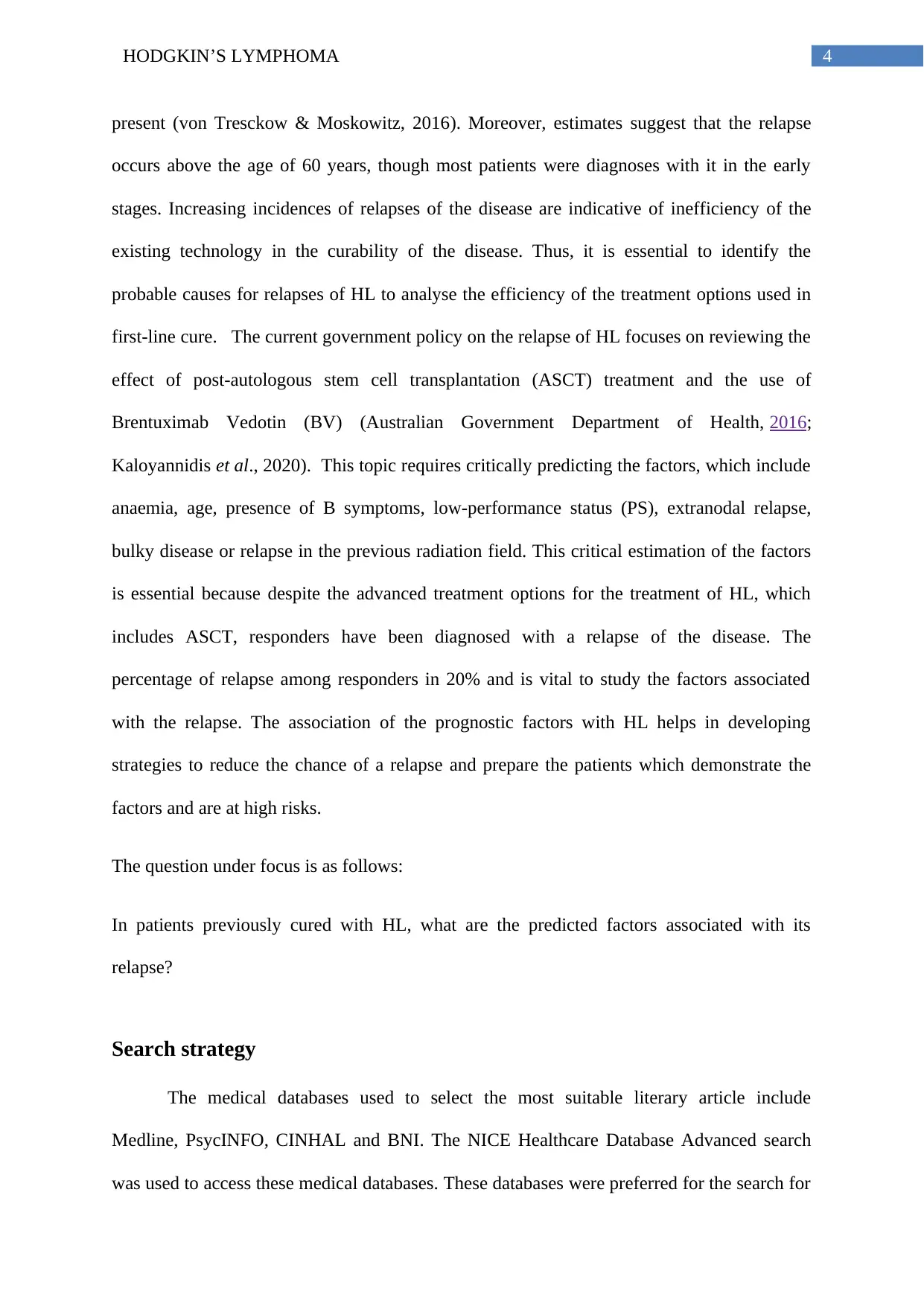
4HODGKIN’S LYMPHOMA
present (von Tresckow & Moskowitz, 2016). Moreover, estimates suggest that the relapse
occurs above the age of 60 years, though most patients were diagnoses with it in the early
stages. Increasing incidences of relapses of the disease are indicative of inefficiency of the
existing technology in the curability of the disease. Thus, it is essential to identify the
probable causes for relapses of HL to analyse the efficiency of the treatment options used in
first-line cure. The current government policy on the relapse of HL focuses on reviewing the
effect of post-autologous stem cell transplantation (ASCT) treatment and the use of
Brentuximab Vedotin (BV) (Australian Government Department of Health, 2016;
Kaloyannidis et al., 2020). This topic requires critically predicting the factors, which include
anaemia, age, presence of B symptoms, low-performance status (PS), extranodal relapse,
bulky disease or relapse in the previous radiation field. This critical estimation of the factors
is essential because despite the advanced treatment options for the treatment of HL, which
includes ASCT, responders have been diagnosed with a relapse of the disease. The
percentage of relapse among responders in 20% and is vital to study the factors associated
with the relapse. The association of the prognostic factors with HL helps in developing
strategies to reduce the chance of a relapse and prepare the patients which demonstrate the
factors and are at high risks.
The question under focus is as follows:
In patients previously cured with HL, what are the predicted factors associated with its
relapse?
Search strategy
The medical databases used to select the most suitable literary article include
Medline, PsycINFO, CINHAL and BNI. The NICE Healthcare Database Advanced search
was used to access these medical databases. These databases were preferred for the search for
present (von Tresckow & Moskowitz, 2016). Moreover, estimates suggest that the relapse
occurs above the age of 60 years, though most patients were diagnoses with it in the early
stages. Increasing incidences of relapses of the disease are indicative of inefficiency of the
existing technology in the curability of the disease. Thus, it is essential to identify the
probable causes for relapses of HL to analyse the efficiency of the treatment options used in
first-line cure. The current government policy on the relapse of HL focuses on reviewing the
effect of post-autologous stem cell transplantation (ASCT) treatment and the use of
Brentuximab Vedotin (BV) (Australian Government Department of Health, 2016;
Kaloyannidis et al., 2020). This topic requires critically predicting the factors, which include
anaemia, age, presence of B symptoms, low-performance status (PS), extranodal relapse,
bulky disease or relapse in the previous radiation field. This critical estimation of the factors
is essential because despite the advanced treatment options for the treatment of HL, which
includes ASCT, responders have been diagnosed with a relapse of the disease. The
percentage of relapse among responders in 20% and is vital to study the factors associated
with the relapse. The association of the prognostic factors with HL helps in developing
strategies to reduce the chance of a relapse and prepare the patients which demonstrate the
factors and are at high risks.
The question under focus is as follows:
In patients previously cured with HL, what are the predicted factors associated with its
relapse?
Search strategy
The medical databases used to select the most suitable literary article include
Medline, PsycINFO, CINHAL and BNI. The NICE Healthcare Database Advanced search
was used to access these medical databases. These databases were preferred for the search for
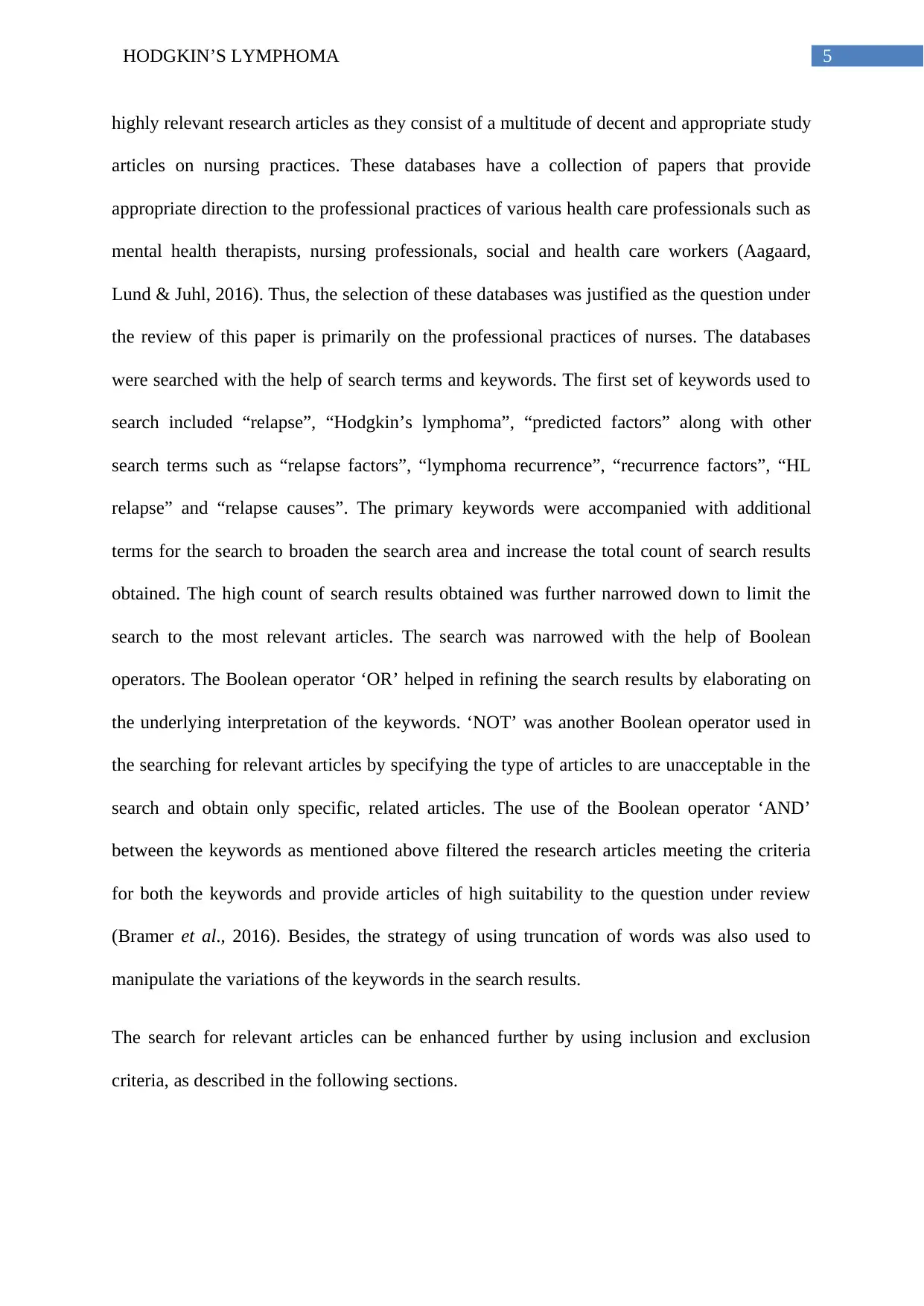
5HODGKIN’S LYMPHOMA
highly relevant research articles as they consist of a multitude of decent and appropriate study
articles on nursing practices. These databases have a collection of papers that provide
appropriate direction to the professional practices of various health care professionals such as
mental health therapists, nursing professionals, social and health care workers (Aagaard,
Lund & Juhl, 2016). Thus, the selection of these databases was justified as the question under
the review of this paper is primarily on the professional practices of nurses. The databases
were searched with the help of search terms and keywords. The first set of keywords used to
search included “relapse”, “Hodgkin’s lymphoma”, “predicted factors” along with other
search terms such as “relapse factors”, “lymphoma recurrence”, “recurrence factors”, “HL
relapse” and “relapse causes”. The primary keywords were accompanied with additional
terms for the search to broaden the search area and increase the total count of search results
obtained. The high count of search results obtained was further narrowed down to limit the
search to the most relevant articles. The search was narrowed with the help of Boolean
operators. The Boolean operator ‘OR’ helped in refining the search results by elaborating on
the underlying interpretation of the keywords. ‘NOT’ was another Boolean operator used in
the searching for relevant articles by specifying the type of articles to are unacceptable in the
search and obtain only specific, related articles. The use of the Boolean operator ‘AND’
between the keywords as mentioned above filtered the research articles meeting the criteria
for both the keywords and provide articles of high suitability to the question under review
(Bramer et al., 2016). Besides, the strategy of using truncation of words was also used to
manipulate the variations of the keywords in the search results.
The search for relevant articles can be enhanced further by using inclusion and exclusion
criteria, as described in the following sections.
highly relevant research articles as they consist of a multitude of decent and appropriate study
articles on nursing practices. These databases have a collection of papers that provide
appropriate direction to the professional practices of various health care professionals such as
mental health therapists, nursing professionals, social and health care workers (Aagaard,
Lund & Juhl, 2016). Thus, the selection of these databases was justified as the question under
the review of this paper is primarily on the professional practices of nurses. The databases
were searched with the help of search terms and keywords. The first set of keywords used to
search included “relapse”, “Hodgkin’s lymphoma”, “predicted factors” along with other
search terms such as “relapse factors”, “lymphoma recurrence”, “recurrence factors”, “HL
relapse” and “relapse causes”. The primary keywords were accompanied with additional
terms for the search to broaden the search area and increase the total count of search results
obtained. The high count of search results obtained was further narrowed down to limit the
search to the most relevant articles. The search was narrowed with the help of Boolean
operators. The Boolean operator ‘OR’ helped in refining the search results by elaborating on
the underlying interpretation of the keywords. ‘NOT’ was another Boolean operator used in
the searching for relevant articles by specifying the type of articles to are unacceptable in the
search and obtain only specific, related articles. The use of the Boolean operator ‘AND’
between the keywords as mentioned above filtered the research articles meeting the criteria
for both the keywords and provide articles of high suitability to the question under review
(Bramer et al., 2016). Besides, the strategy of using truncation of words was also used to
manipulate the variations of the keywords in the search results.
The search for relevant articles can be enhanced further by using inclusion and exclusion
criteria, as described in the following sections.
⊘ This is a preview!⊘
Do you want full access?
Subscribe today to unlock all pages.

Trusted by 1+ million students worldwide
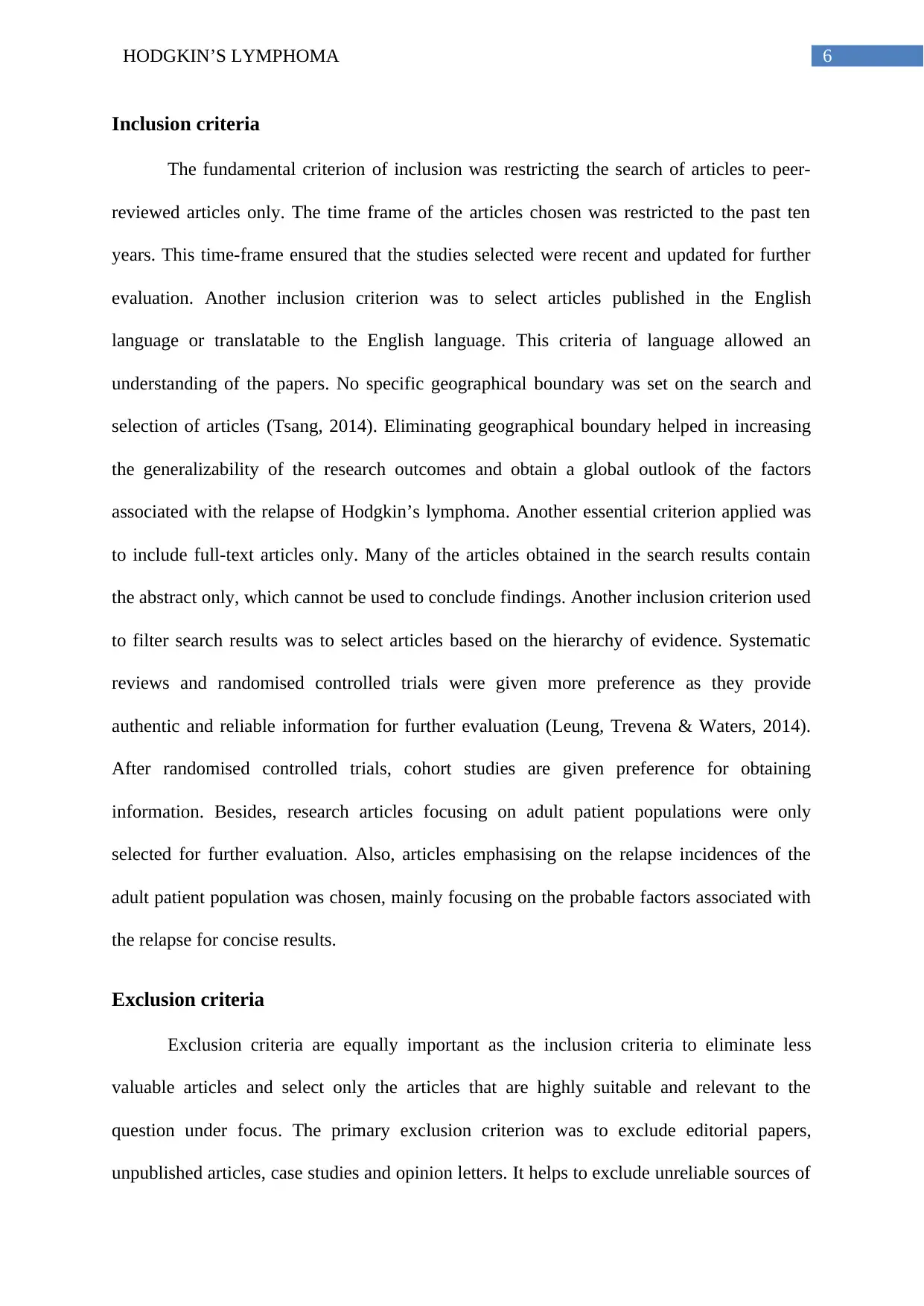
6HODGKIN’S LYMPHOMA
Inclusion criteria
The fundamental criterion of inclusion was restricting the search of articles to peer-
reviewed articles only. The time frame of the articles chosen was restricted to the past ten
years. This time-frame ensured that the studies selected were recent and updated for further
evaluation. Another inclusion criterion was to select articles published in the English
language or translatable to the English language. This criteria of language allowed an
understanding of the papers. No specific geographical boundary was set on the search and
selection of articles (Tsang, 2014). Eliminating geographical boundary helped in increasing
the generalizability of the research outcomes and obtain a global outlook of the factors
associated with the relapse of Hodgkin’s lymphoma. Another essential criterion applied was
to include full-text articles only. Many of the articles obtained in the search results contain
the abstract only, which cannot be used to conclude findings. Another inclusion criterion used
to filter search results was to select articles based on the hierarchy of evidence. Systematic
reviews and randomised controlled trials were given more preference as they provide
authentic and reliable information for further evaluation (Leung, Trevena & Waters, 2014).
After randomised controlled trials, cohort studies are given preference for obtaining
information. Besides, research articles focusing on adult patient populations were only
selected for further evaluation. Also, articles emphasising on the relapse incidences of the
adult patient population was chosen, mainly focusing on the probable factors associated with
the relapse for concise results.
Exclusion criteria
Exclusion criteria are equally important as the inclusion criteria to eliminate less
valuable articles and select only the articles that are highly suitable and relevant to the
question under focus. The primary exclusion criterion was to exclude editorial papers,
unpublished articles, case studies and opinion letters. It helps to exclude unreliable sources of
Inclusion criteria
The fundamental criterion of inclusion was restricting the search of articles to peer-
reviewed articles only. The time frame of the articles chosen was restricted to the past ten
years. This time-frame ensured that the studies selected were recent and updated for further
evaluation. Another inclusion criterion was to select articles published in the English
language or translatable to the English language. This criteria of language allowed an
understanding of the papers. No specific geographical boundary was set on the search and
selection of articles (Tsang, 2014). Eliminating geographical boundary helped in increasing
the generalizability of the research outcomes and obtain a global outlook of the factors
associated with the relapse of Hodgkin’s lymphoma. Another essential criterion applied was
to include full-text articles only. Many of the articles obtained in the search results contain
the abstract only, which cannot be used to conclude findings. Another inclusion criterion used
to filter search results was to select articles based on the hierarchy of evidence. Systematic
reviews and randomised controlled trials were given more preference as they provide
authentic and reliable information for further evaluation (Leung, Trevena & Waters, 2014).
After randomised controlled trials, cohort studies are given preference for obtaining
information. Besides, research articles focusing on adult patient populations were only
selected for further evaluation. Also, articles emphasising on the relapse incidences of the
adult patient population was chosen, mainly focusing on the probable factors associated with
the relapse for concise results.
Exclusion criteria
Exclusion criteria are equally important as the inclusion criteria to eliminate less
valuable articles and select only the articles that are highly suitable and relevant to the
question under focus. The primary exclusion criterion was to exclude editorial papers,
unpublished articles, case studies and opinion letters. It helps to exclude unreliable sources of
Paraphrase This Document
Need a fresh take? Get an instant paraphrase of this document with our AI Paraphraser
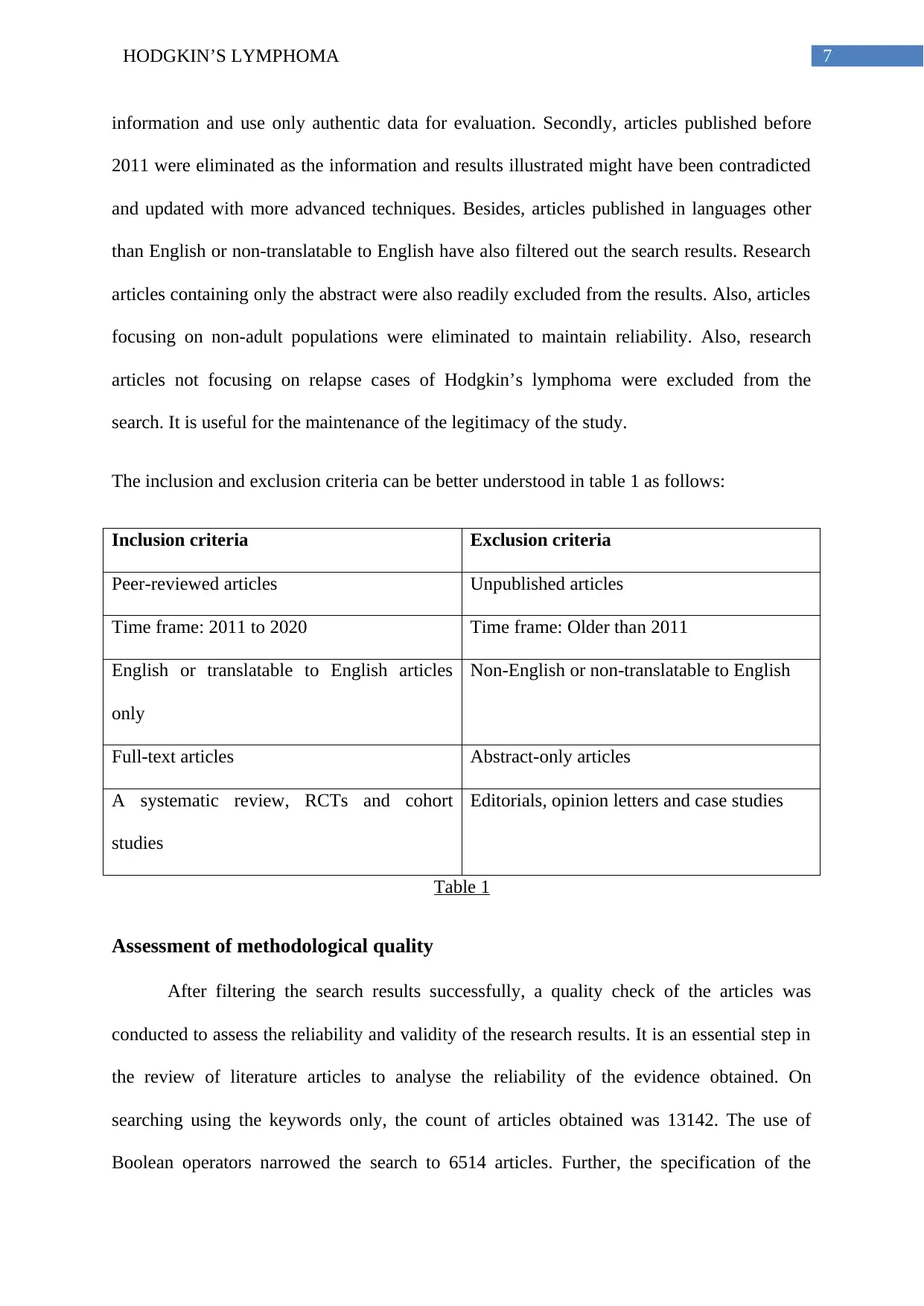
7HODGKIN’S LYMPHOMA
information and use only authentic data for evaluation. Secondly, articles published before
2011 were eliminated as the information and results illustrated might have been contradicted
and updated with more advanced techniques. Besides, articles published in languages other
than English or non-translatable to English have also filtered out the search results. Research
articles containing only the abstract were also readily excluded from the results. Also, articles
focusing on non-adult populations were eliminated to maintain reliability. Also, research
articles not focusing on relapse cases of Hodgkin’s lymphoma were excluded from the
search. It is useful for the maintenance of the legitimacy of the study.
The inclusion and exclusion criteria can be better understood in table 1 as follows:
Inclusion criteria Exclusion criteria
Peer-reviewed articles Unpublished articles
Time frame: 2011 to 2020 Time frame: Older than 2011
English or translatable to English articles
only
Non-English or non-translatable to English
Full-text articles Abstract-only articles
A systematic review, RCTs and cohort
studies
Editorials, opinion letters and case studies
Table 1
Assessment of methodological quality
After filtering the search results successfully, a quality check of the articles was
conducted to assess the reliability and validity of the research results. It is an essential step in
the review of literature articles to analyse the reliability of the evidence obtained. On
searching using the keywords only, the count of articles obtained was 13142. The use of
Boolean operators narrowed the search to 6514 articles. Further, the specification of the
information and use only authentic data for evaluation. Secondly, articles published before
2011 were eliminated as the information and results illustrated might have been contradicted
and updated with more advanced techniques. Besides, articles published in languages other
than English or non-translatable to English have also filtered out the search results. Research
articles containing only the abstract were also readily excluded from the results. Also, articles
focusing on non-adult populations were eliminated to maintain reliability. Also, research
articles not focusing on relapse cases of Hodgkin’s lymphoma were excluded from the
search. It is useful for the maintenance of the legitimacy of the study.
The inclusion and exclusion criteria can be better understood in table 1 as follows:
Inclusion criteria Exclusion criteria
Peer-reviewed articles Unpublished articles
Time frame: 2011 to 2020 Time frame: Older than 2011
English or translatable to English articles
only
Non-English or non-translatable to English
Full-text articles Abstract-only articles
A systematic review, RCTs and cohort
studies
Editorials, opinion letters and case studies
Table 1
Assessment of methodological quality
After filtering the search results successfully, a quality check of the articles was
conducted to assess the reliability and validity of the research results. It is an essential step in
the review of literature articles to analyse the reliability of the evidence obtained. On
searching using the keywords only, the count of articles obtained was 13142. The use of
Boolean operators narrowed the search to 6514 articles. Further, the specification of the
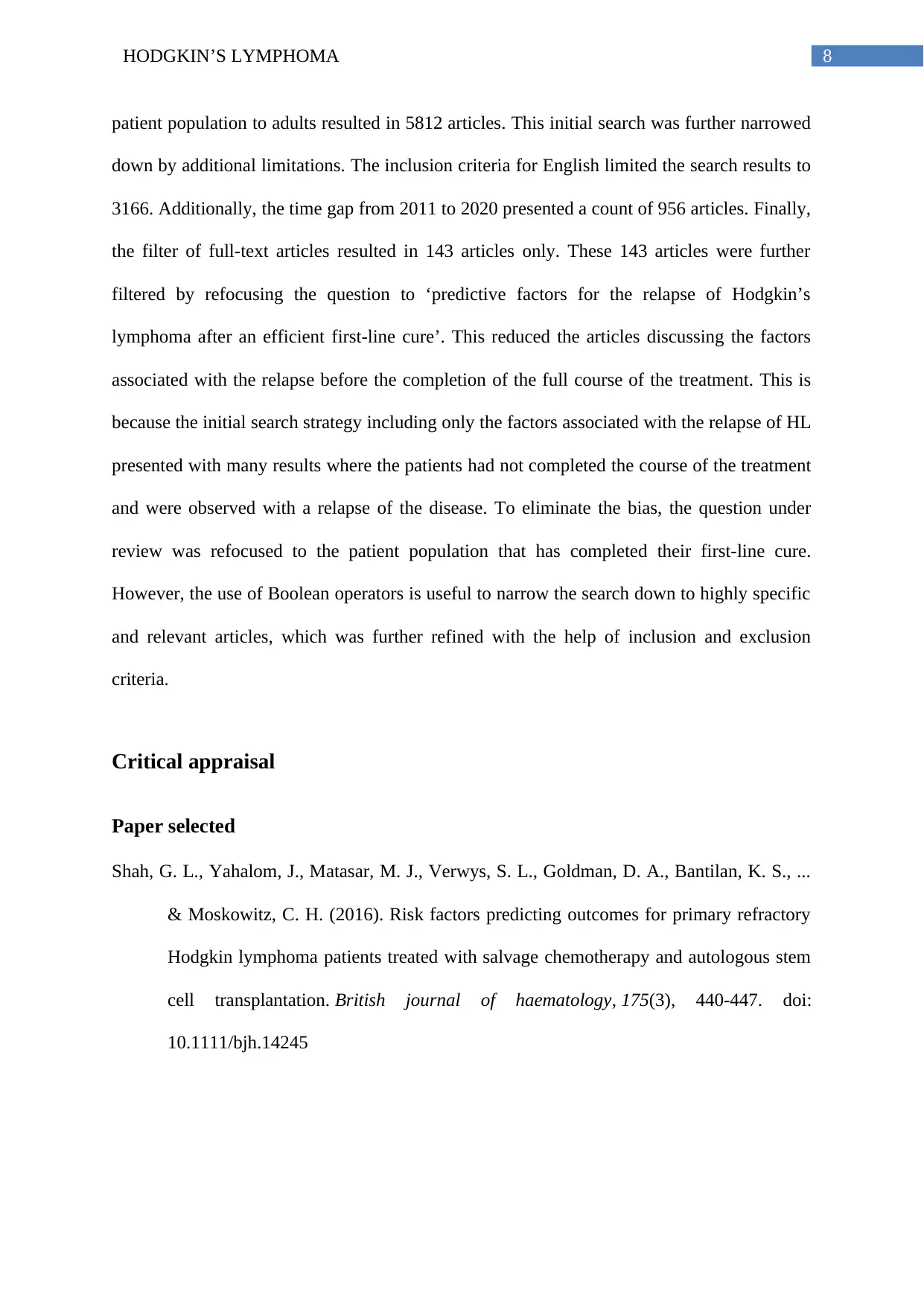
8HODGKIN’S LYMPHOMA
patient population to adults resulted in 5812 articles. This initial search was further narrowed
down by additional limitations. The inclusion criteria for English limited the search results to
3166. Additionally, the time gap from 2011 to 2020 presented a count of 956 articles. Finally,
the filter of full-text articles resulted in 143 articles only. These 143 articles were further
filtered by refocusing the question to ‘predictive factors for the relapse of Hodgkin’s
lymphoma after an efficient first-line cure’. This reduced the articles discussing the factors
associated with the relapse before the completion of the full course of the treatment. This is
because the initial search strategy including only the factors associated with the relapse of HL
presented with many results where the patients had not completed the course of the treatment
and were observed with a relapse of the disease. To eliminate the bias, the question under
review was refocused to the patient population that has completed their first-line cure.
However, the use of Boolean operators is useful to narrow the search down to highly specific
and relevant articles, which was further refined with the help of inclusion and exclusion
criteria.
Critical appraisal
Paper selected
Shah, G. L., Yahalom, J., Matasar, M. J., Verwys, S. L., Goldman, D. A., Bantilan, K. S., ...
& Moskowitz, C. H. (2016). Risk factors predicting outcomes for primary refractory
Hodgkin lymphoma patients treated with salvage chemotherapy and autologous stem
cell transplantation. British journal of haematology, 175(3), 440-447. doi:
10.1111/bjh.14245
patient population to adults resulted in 5812 articles. This initial search was further narrowed
down by additional limitations. The inclusion criteria for English limited the search results to
3166. Additionally, the time gap from 2011 to 2020 presented a count of 956 articles. Finally,
the filter of full-text articles resulted in 143 articles only. These 143 articles were further
filtered by refocusing the question to ‘predictive factors for the relapse of Hodgkin’s
lymphoma after an efficient first-line cure’. This reduced the articles discussing the factors
associated with the relapse before the completion of the full course of the treatment. This is
because the initial search strategy including only the factors associated with the relapse of HL
presented with many results where the patients had not completed the course of the treatment
and were observed with a relapse of the disease. To eliminate the bias, the question under
review was refocused to the patient population that has completed their first-line cure.
However, the use of Boolean operators is useful to narrow the search down to highly specific
and relevant articles, which was further refined with the help of inclusion and exclusion
criteria.
Critical appraisal
Paper selected
Shah, G. L., Yahalom, J., Matasar, M. J., Verwys, S. L., Goldman, D. A., Bantilan, K. S., ...
& Moskowitz, C. H. (2016). Risk factors predicting outcomes for primary refractory
Hodgkin lymphoma patients treated with salvage chemotherapy and autologous stem
cell transplantation. British journal of haematology, 175(3), 440-447. doi:
10.1111/bjh.14245
⊘ This is a preview!⊘
Do you want full access?
Subscribe today to unlock all pages.

Trusted by 1+ million students worldwide
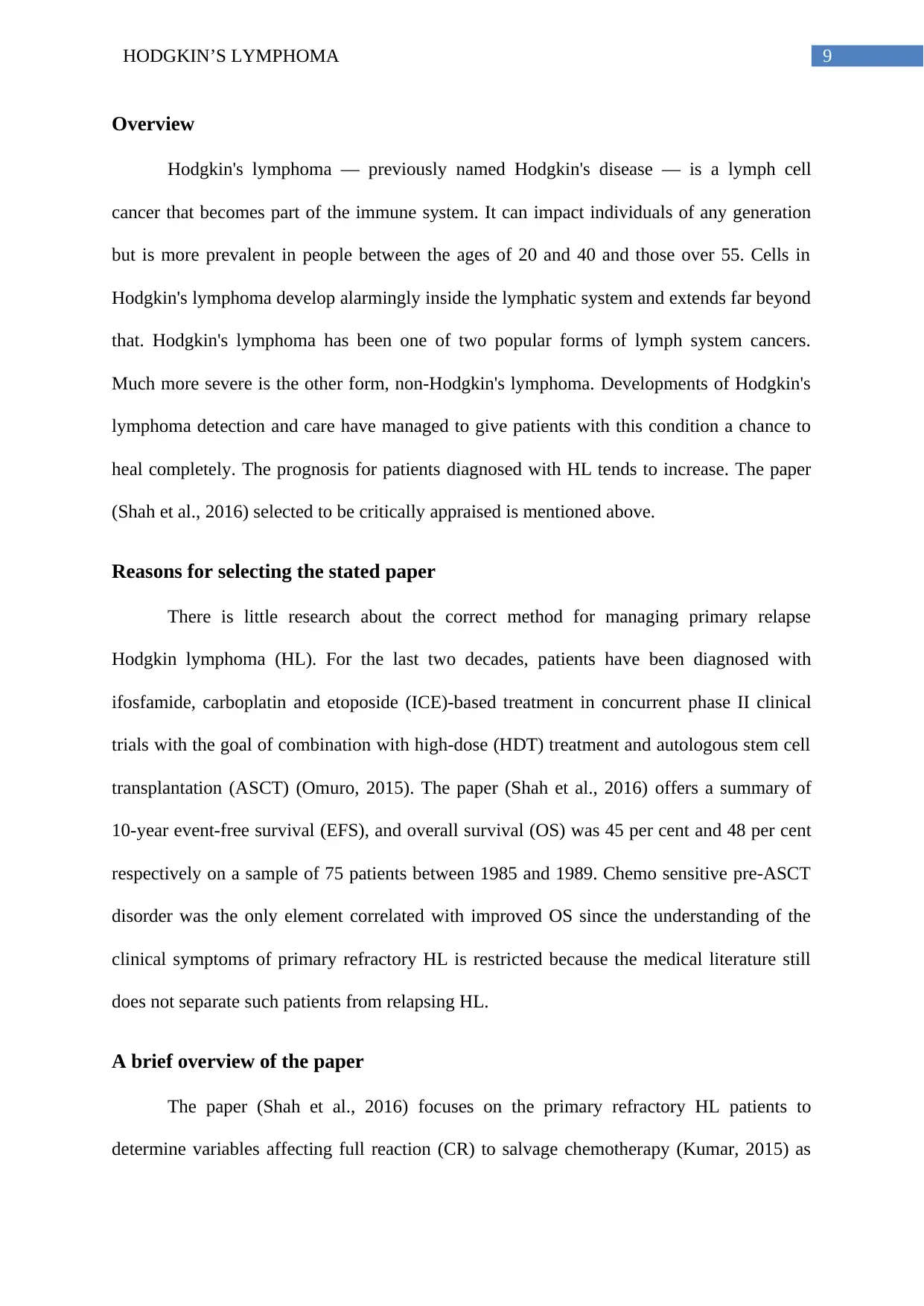
9HODGKIN’S LYMPHOMA
Overview
Hodgkin's lymphoma — previously named Hodgkin's disease — is a lymph cell
cancer that becomes part of the immune system. It can impact individuals of any generation
but is more prevalent in people between the ages of 20 and 40 and those over 55. Cells in
Hodgkin's lymphoma develop alarmingly inside the lymphatic system and extends far beyond
that. Hodgkin's lymphoma has been one of two popular forms of lymph system cancers.
Much more severe is the other form, non-Hodgkin's lymphoma. Developments of Hodgkin's
lymphoma detection and care have managed to give patients with this condition a chance to
heal completely. The prognosis for patients diagnosed with HL tends to increase. The paper
(Shah et al., 2016) selected to be critically appraised is mentioned above.
Reasons for selecting the stated paper
There is little research about the correct method for managing primary relapse
Hodgkin lymphoma (HL). For the last two decades, patients have been diagnosed with
ifosfamide, carboplatin and etoposide (ICE)-based treatment in concurrent phase II clinical
trials with the goal of combination with high-dose (HDT) treatment and autologous stem cell
transplantation (ASCT) (Omuro, 2015). The paper (Shah et al., 2016) offers a summary of
10-year event-free survival (EFS), and overall survival (OS) was 45 per cent and 48 per cent
respectively on a sample of 75 patients between 1985 and 1989. Chemo sensitive pre-ASCT
disorder was the only element correlated with improved OS since the understanding of the
clinical symptoms of primary refractory HL is restricted because the medical literature still
does not separate such patients from relapsing HL.
A brief overview of the paper
The paper (Shah et al., 2016) focuses on the primary refractory HL patients to
determine variables affecting full reaction (CR) to salvage chemotherapy (Kumar, 2015) as
Overview
Hodgkin's lymphoma — previously named Hodgkin's disease — is a lymph cell
cancer that becomes part of the immune system. It can impact individuals of any generation
but is more prevalent in people between the ages of 20 and 40 and those over 55. Cells in
Hodgkin's lymphoma develop alarmingly inside the lymphatic system and extends far beyond
that. Hodgkin's lymphoma has been one of two popular forms of lymph system cancers.
Much more severe is the other form, non-Hodgkin's lymphoma. Developments of Hodgkin's
lymphoma detection and care have managed to give patients with this condition a chance to
heal completely. The prognosis for patients diagnosed with HL tends to increase. The paper
(Shah et al., 2016) selected to be critically appraised is mentioned above.
Reasons for selecting the stated paper
There is little research about the correct method for managing primary relapse
Hodgkin lymphoma (HL). For the last two decades, patients have been diagnosed with
ifosfamide, carboplatin and etoposide (ICE)-based treatment in concurrent phase II clinical
trials with the goal of combination with high-dose (HDT) treatment and autologous stem cell
transplantation (ASCT) (Omuro, 2015). The paper (Shah et al., 2016) offers a summary of
10-year event-free survival (EFS), and overall survival (OS) was 45 per cent and 48 per cent
respectively on a sample of 75 patients between 1985 and 1989. Chemo sensitive pre-ASCT
disorder was the only element correlated with improved OS since the understanding of the
clinical symptoms of primary refractory HL is restricted because the medical literature still
does not separate such patients from relapsing HL.
A brief overview of the paper
The paper (Shah et al., 2016) focuses on the primary refractory HL patients to
determine variables affecting full reaction (CR) to salvage chemotherapy (Kumar, 2015) as
Paraphrase This Document
Need a fresh take? Get an instant paraphrase of this document with our AI Paraphraser
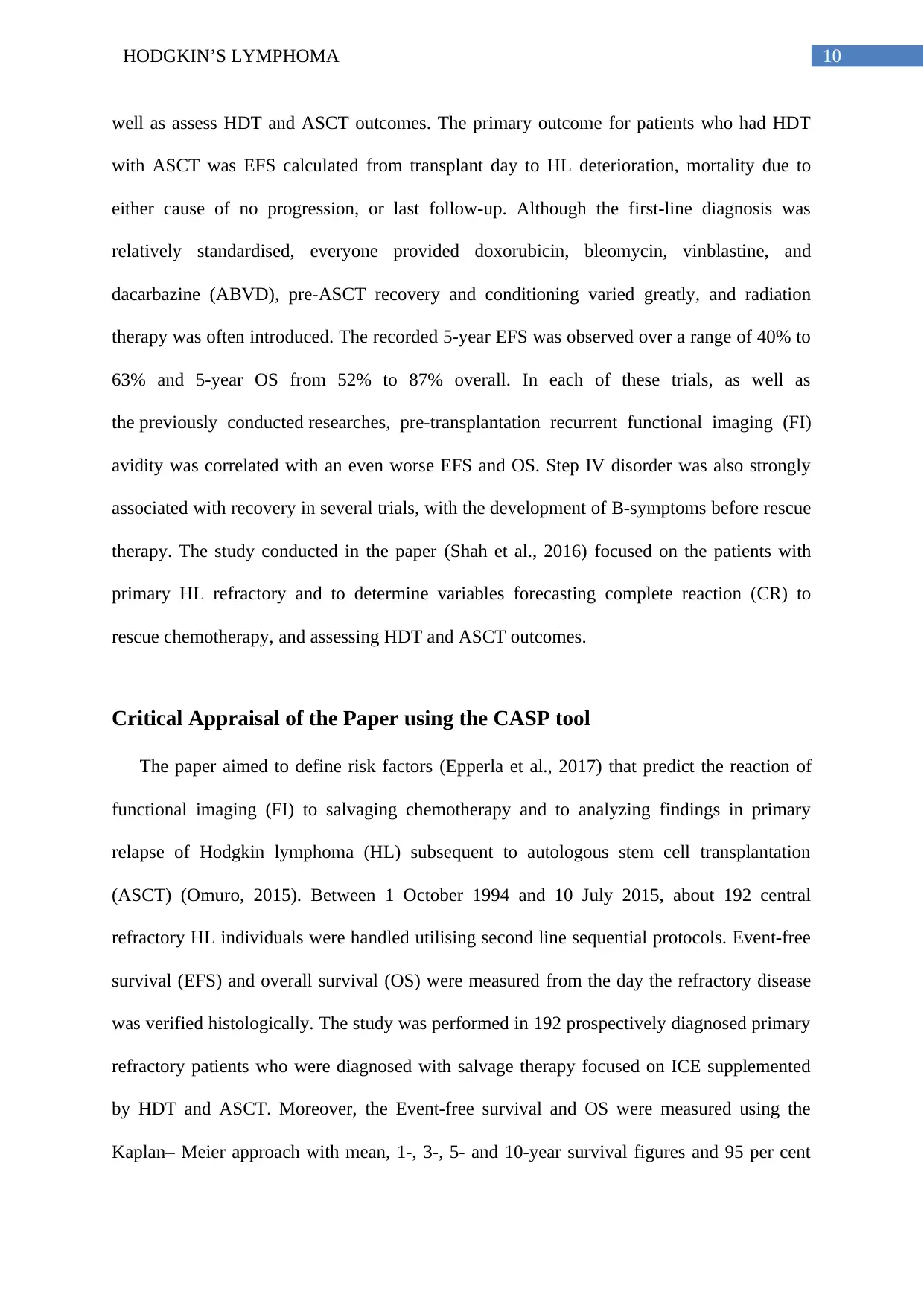
10HODGKIN’S LYMPHOMA
well as assess HDT and ASCT outcomes. The primary outcome for patients who had HDT
with ASCT was EFS calculated from transplant day to HL deterioration, mortality due to
either cause of no progression, or last follow-up. Although the first-line diagnosis was
relatively standardised, everyone provided doxorubicin, bleomycin, vinblastine, and
dacarbazine (ABVD), pre-ASCT recovery and conditioning varied greatly, and radiation
therapy was often introduced. The recorded 5-year EFS was observed over a range of 40% to
63% and 5-year OS from 52% to 87% overall. In each of these trials, as well as
the previously conducted researches, pre-transplantation recurrent functional imaging (FI)
avidity was correlated with an even worse EFS and OS. Step IV disorder was also strongly
associated with recovery in several trials, with the development of B-symptoms before rescue
therapy. The study conducted in the paper (Shah et al., 2016) focused on the patients with
primary HL refractory and to determine variables forecasting complete reaction (CR) to
rescue chemotherapy, and assessing HDT and ASCT outcomes.
Critical Appraisal of the Paper using the CASP tool
The paper aimed to define risk factors (Epperla et al., 2017) that predict the reaction of
functional imaging (FI) to salvaging chemotherapy and to analyzing findings in primary
relapse of Hodgkin lymphoma (HL) subsequent to autologous stem cell transplantation
(ASCT) (Omuro, 2015). Between 1 October 1994 and 10 July 2015, about 192 central
refractory HL individuals were handled utilising second line sequential protocols. Event-free
survival (EFS) and overall survival (OS) were measured from the day the refractory disease
was verified histologically. The study was performed in 192 prospectively diagnosed primary
refractory patients who were diagnosed with salvage therapy focused on ICE supplemented
by HDT and ASCT. Moreover, the Event-free survival and OS were measured using the
Kaplan– Meier approach with mean, 1-, 3-, 5- and 10-year survival figures and 95 per cent
well as assess HDT and ASCT outcomes. The primary outcome for patients who had HDT
with ASCT was EFS calculated from transplant day to HL deterioration, mortality due to
either cause of no progression, or last follow-up. Although the first-line diagnosis was
relatively standardised, everyone provided doxorubicin, bleomycin, vinblastine, and
dacarbazine (ABVD), pre-ASCT recovery and conditioning varied greatly, and radiation
therapy was often introduced. The recorded 5-year EFS was observed over a range of 40% to
63% and 5-year OS from 52% to 87% overall. In each of these trials, as well as
the previously conducted researches, pre-transplantation recurrent functional imaging (FI)
avidity was correlated with an even worse EFS and OS. Step IV disorder was also strongly
associated with recovery in several trials, with the development of B-symptoms before rescue
therapy. The study conducted in the paper (Shah et al., 2016) focused on the patients with
primary HL refractory and to determine variables forecasting complete reaction (CR) to
rescue chemotherapy, and assessing HDT and ASCT outcomes.
Critical Appraisal of the Paper using the CASP tool
The paper aimed to define risk factors (Epperla et al., 2017) that predict the reaction of
functional imaging (FI) to salvaging chemotherapy and to analyzing findings in primary
relapse of Hodgkin lymphoma (HL) subsequent to autologous stem cell transplantation
(ASCT) (Omuro, 2015). Between 1 October 1994 and 10 July 2015, about 192 central
refractory HL individuals were handled utilising second line sequential protocols. Event-free
survival (EFS) and overall survival (OS) were measured from the day the refractory disease
was verified histologically. The study was performed in 192 prospectively diagnosed primary
refractory patients who were diagnosed with salvage therapy focused on ICE supplemented
by HDT and ASCT. Moreover, the Event-free survival and OS were measured using the
Kaplan– Meier approach with mean, 1-, 3-, 5- and 10-year survival figures and 95 per cent
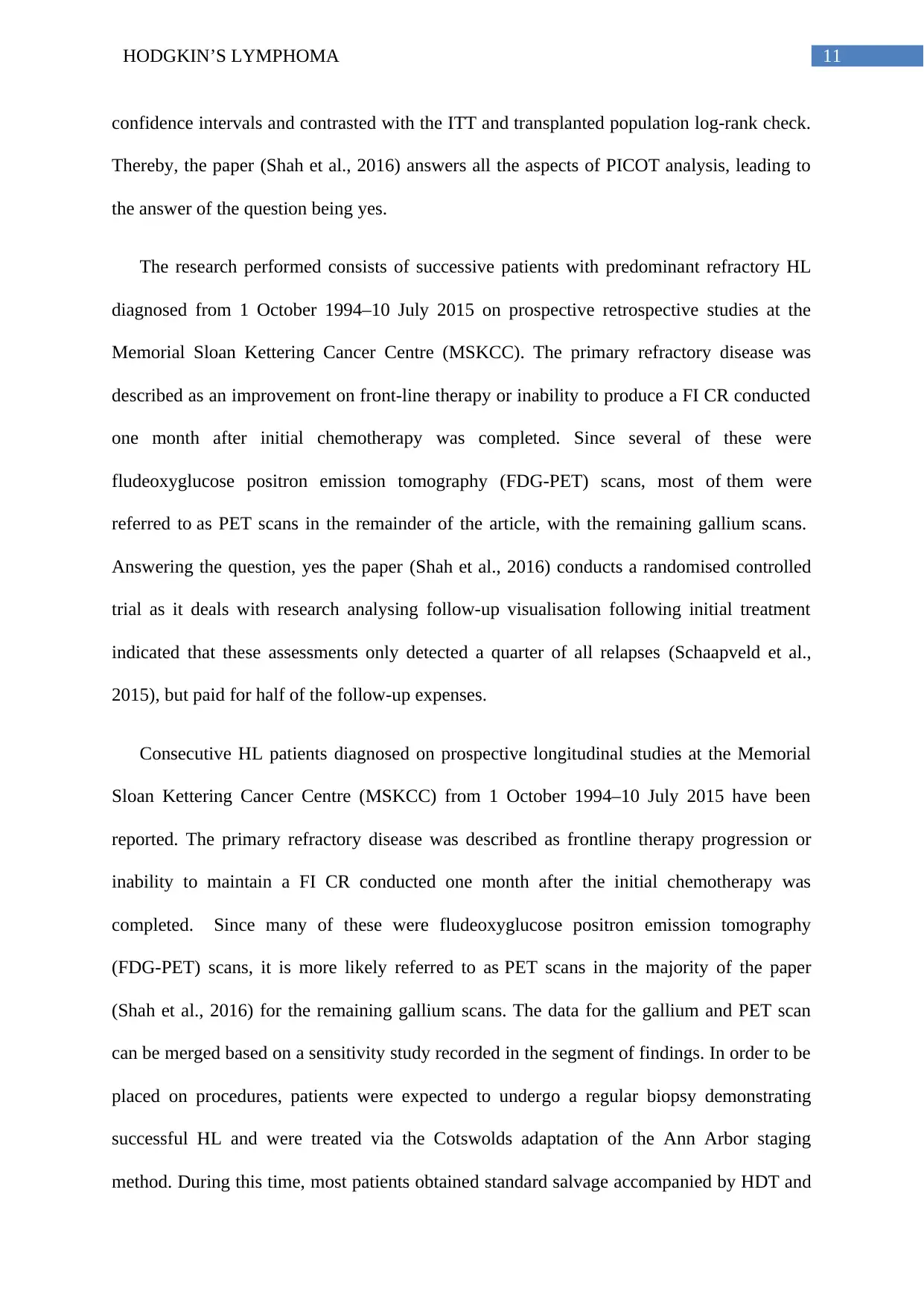
11HODGKIN’S LYMPHOMA
confidence intervals and contrasted with the ITT and transplanted population log-rank check.
Thereby, the paper (Shah et al., 2016) answers all the aspects of PICOT analysis, leading to
the answer of the question being yes.
The research performed consists of successive patients with predominant refractory HL
diagnosed from 1 October 1994–10 July 2015 on prospective retrospective studies at the
Memorial Sloan Kettering Cancer Centre (MSKCC). The primary refractory disease was
described as an improvement on front-line therapy or inability to produce a FI CR conducted
one month after initial chemotherapy was completed. Since several of these were
fludeoxyglucose positron emission tomography (FDG-PET) scans, most of them were
referred to as PET scans in the remainder of the article, with the remaining gallium scans.
Answering the question, yes the paper (Shah et al., 2016) conducts a randomised controlled
trial as it deals with research analysing follow-up visualisation following initial treatment
indicated that these assessments only detected a quarter of all relapses (Schaapveld et al.,
2015), but paid for half of the follow-up expenses.
Consecutive HL patients diagnosed on prospective longitudinal studies at the Memorial
Sloan Kettering Cancer Centre (MSKCC) from 1 October 1994–10 July 2015 have been
reported. The primary refractory disease was described as frontline therapy progression or
inability to maintain a FI CR conducted one month after the initial chemotherapy was
completed. Since many of these were fludeoxyglucose positron emission tomography
(FDG-PET) scans, it is more likely referred to as PET scans in the majority of the paper
(Shah et al., 2016) for the remaining gallium scans. The data for the gallium and PET scan
can be merged based on a sensitivity study recorded in the segment of findings. In order to be
placed on procedures, patients were expected to undergo a regular biopsy demonstrating
successful HL and were treated via the Cotswolds adaptation of the Ann Arbor staging
method. During this time, most patients obtained standard salvage accompanied by HDT and
confidence intervals and contrasted with the ITT and transplanted population log-rank check.
Thereby, the paper (Shah et al., 2016) answers all the aspects of PICOT analysis, leading to
the answer of the question being yes.
The research performed consists of successive patients with predominant refractory HL
diagnosed from 1 October 1994–10 July 2015 on prospective retrospective studies at the
Memorial Sloan Kettering Cancer Centre (MSKCC). The primary refractory disease was
described as an improvement on front-line therapy or inability to produce a FI CR conducted
one month after initial chemotherapy was completed. Since several of these were
fludeoxyglucose positron emission tomography (FDG-PET) scans, most of them were
referred to as PET scans in the remainder of the article, with the remaining gallium scans.
Answering the question, yes the paper (Shah et al., 2016) conducts a randomised controlled
trial as it deals with research analysing follow-up visualisation following initial treatment
indicated that these assessments only detected a quarter of all relapses (Schaapveld et al.,
2015), but paid for half of the follow-up expenses.
Consecutive HL patients diagnosed on prospective longitudinal studies at the Memorial
Sloan Kettering Cancer Centre (MSKCC) from 1 October 1994–10 July 2015 have been
reported. The primary refractory disease was described as frontline therapy progression or
inability to maintain a FI CR conducted one month after the initial chemotherapy was
completed. Since many of these were fludeoxyglucose positron emission tomography
(FDG-PET) scans, it is more likely referred to as PET scans in the majority of the paper
(Shah et al., 2016) for the remaining gallium scans. The data for the gallium and PET scan
can be merged based on a sensitivity study recorded in the segment of findings. In order to be
placed on procedures, patients were expected to undergo a regular biopsy demonstrating
successful HL and were treated via the Cotswolds adaptation of the Ann Arbor staging
method. During this time, most patients obtained standard salvage accompanied by HDT and
⊘ This is a preview!⊘
Do you want full access?
Subscribe today to unlock all pages.

Trusted by 1+ million students worldwide
1 out of 20
Related Documents
Your All-in-One AI-Powered Toolkit for Academic Success.
+13062052269
info@desklib.com
Available 24*7 on WhatsApp / Email
![[object Object]](/_next/static/media/star-bottom.7253800d.svg)
Unlock your academic potential
Copyright © 2020–2025 A2Z Services. All Rights Reserved. Developed and managed by ZUCOL.




